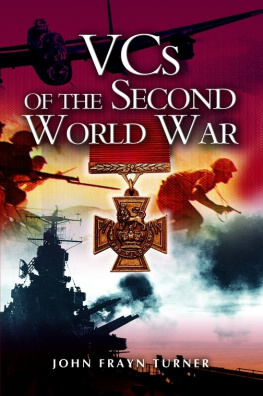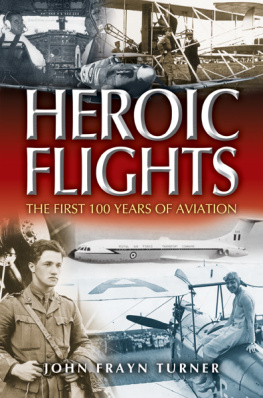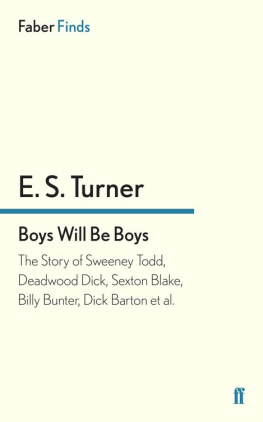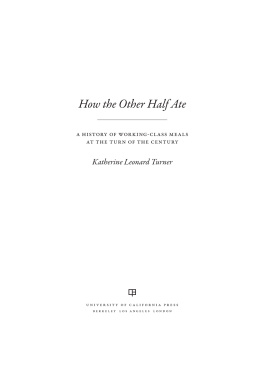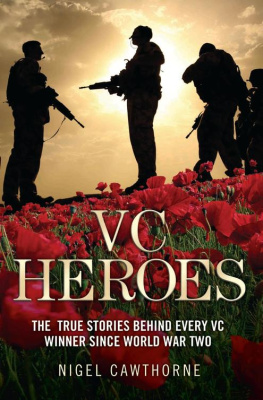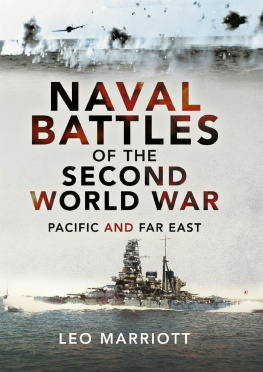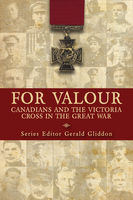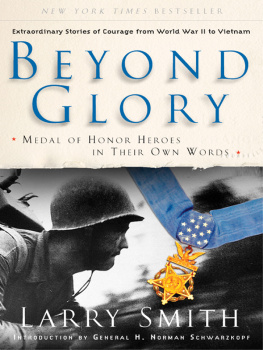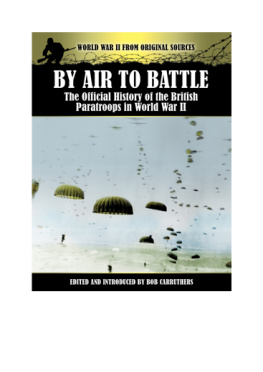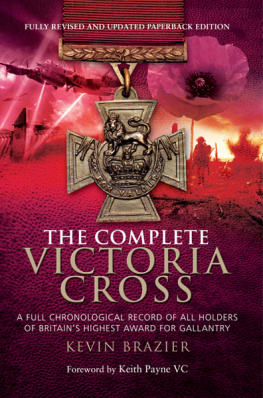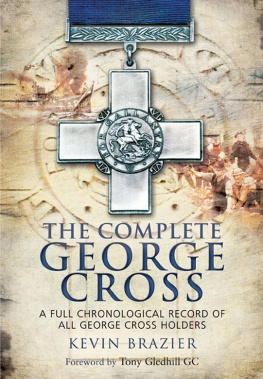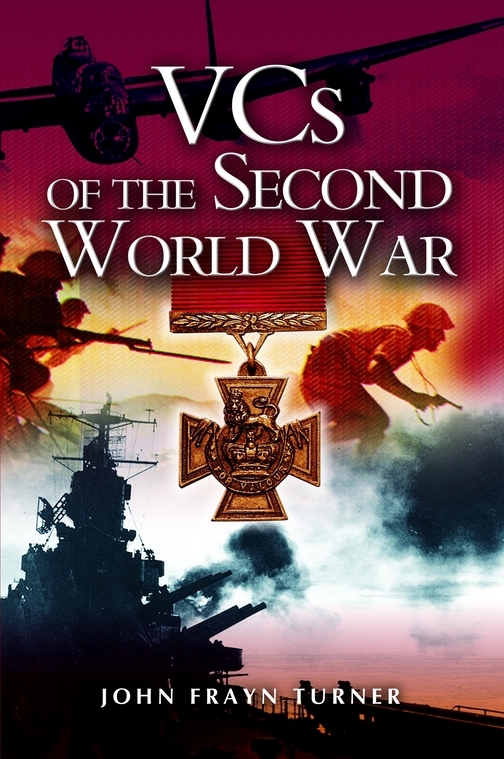I would like to thank the staff of the Reference Library of the Imperial War Museum for their help. I have also received assistance in the past from the Press Office of the Ministry of Defence.
I wish to express my sincere gratitude for permission to reproduce or adapt accounts of actions from the following: The Regimental History of the Royal Hampshire Regiment (Gale and Polden Ltd.) which conveys the courage of Major Herbert Wallace Le Patourel, Captain Richard Wakeford, and Lieutenant Gerard Ross Norton; The War in Malaya by Lieutenant General A.E. Percival (Eyre and Spottiswoode Ltd.), describing how Brigadier Arthur Edward Cummings won the VC; Captain R.E.D. Ryder, VC, RN, who wrote his own account of The Attack on St Nazaire (John Murray); Captain G.B. Stanning, DSO, RN, for his narrative of Narvik; C.E.T. Warren and James Benson, authors of Above Us the Waves (George G. Harrap and Co. Ltd.); The Ship Busters by Ralph Barker (Chatto and Windus) on Flying Officer Kenneth Campbell; and finally No. 5 Bomber Group, RAF by W.J. Lawrence (Faber and Faber) for details of the action for which Group Captain Leonard Cheshire was awarded the Victoria Cross.
CHAPTER ONE
The Battle of Narvik
BERNARD WARBURTON-LEE
T he Germans invaded Norway in April 1940 and captured the port of Narvik almost at once. British warships were already lying off the Norwegian coast when the Admiralty immediately flashed orders to Captain Warburton-Lee of the destroyer HMS Hardy : Take three ships and attack Narvik. The youthful Warburton-Lee, or Wash as he was always known, chose the fast H-class destroyers Hotspur , Havock and Hunter to help him execute this dangerous duty.
The Hardy arrived off Tranoy by Vest Fjord and Wash sent a boat ashore to ask local Norwegians what they knew of the enemy. The locals told them that German warships and U-boats were at Narvik. Despite this news, Wash told his officers: Im attacking at dawn. Meanwhile, Hardy steamed up and down the side of Vest Fjord so as not to give away their intentions to anyone spotting them.
At midnight it was snowing hard. Another destroyer, the Hostile had joined the four already there. They altered course to turn up Narvik Fjord. The flotilla of five destroyers edged on, through thickening snow, nearer and nearer to Narvik. They met no enemy. It was then 04.30 hours in an Arctic fjord as they glided like ghosts towards Narvik harbour. An unreal silence and more snow.
The port was still half a mile off. Hardy went in alone. With engines stopped, she just floated forward. Suddenly someone said: There they are. Two enemy destroyers lay alongside each other right in the middle of the harbour with bows turned to the town.
Warburton-Lee ordered: Fire four torpedoes. Then he made twenty knots to take them out of range of retaliation. They saw more destroyers at the quay. One of the torpedoes hit a merchant ship astern of the destroyers. Then came an explosion erupting from the direction of the destroyers. It meant that magazines must have been hit.
As Hardy turned out of the harbour, they fired three more torpedoes in the general direction of the others, and emerged with only one left.
Hardy kept close to the entrance to the harbour in case anything tried to leave. She circled in front of the entrance for the second time, firing her guns at enemy flashes when they lit the snow-backed port behind the ships. Heavier gunfire came from Narvik now from the probably damaged destroyers. Wash was anxious to find out what damage had been inflicted, as they had heard many louder explosions since the first batch earlier. But they could see nothing of the result.
Not only heavy guns aimed at them now. As Hardy crossed the entrance to the southward, torpedoes tore through the fjord towards her. Some came very near, too close for comfort, and one actually seemed to go underneath the ship. Lieutenant Geoffrey Stanning counted six torpedoes, but others saw more and said three went under the vessel. However, none of them hit, nor did they explode. They could be heard from the deck of Hardy as they went ashore on the beach opposite, whirring weirdly, mechanically, as they tried to scramble up the sand. Each of the five H-class destroyers took a turn at the entrance to the harbour, then finally they all withdrew.
Wash asked the others for details of damage or casualties, and how many torpedoes they had left.
No damage, no casualties, came back the signals. And Hostile said she still had a full load of torpedoes.
Mansell told Wash that Hardy had a small hole in the after-funnel, and confirmed that three torpedoes had gone under them. Every one was in high spirits. The second stage of the battle was over, and still no damage had been sustained. All enemy guns seemed to have ceased fire fairly early in this latter attack; perhaps all opposition had been silenced.
Wash called in his officers. What do you think about things now? he wanted to know. Whats it to be withdraw or go in again?
All the while that they had been considering the latest situation, the Hardy was steaming slowly down-fjord. When the Captain made up his mind, they were a way from the harbour entrance. He turned her round, and at first the entrance could not be found again just as it had eluded them before the initial assault. Then they saw the old fishing-boat near the wooden pier. Soon they were at the entrance. The harbour looked in a chaotic state, but it was difficult to discover the damage from previous attacks. Now at any rate they saw that the supposedly British ship near the entrance had been sunk, with her stern pointing mountain-wards, high out of the water.
Then there came a terrible shock.
Wash suddenly sighted three enemy warships heading straight towards them from the direction of Rombaks Fjord. He took them to be a cruiser and two destroyers and gave the order: Engage.
Hardy opened fire on them at the simultaneous second that they attacked. Visibility had increased only a matter of minutes before or the flotilla might have collided with the three enemy vessels. Whether the first was a cruiser or leader destroyer, it certainly looked larger than the others.
Wash thought quickly after the first exchange of salvos. Then he ordered the signal to withdraw a red Very light at thirty knots.
Clark protested that Hardy was hitting them, and wanted to stay. But before another word was possible two more ships appeared ahead.
Cross said: Birminghams.
They were four miles off and looked like our own cruisers. But Stanning snatched up his glasses and caught sight of hoods on their funnels.
Not ours, he said tersely. Then he thumbed through the pages of the Janes which was on the bridge. Large German destroyers, he added with animation.
That clinched it. They were in a tight corner. The two Germans ahead turned sharply to port and opened fire. Hardy engaged them both, leaving the other three to her rear ships. It must have been at this moment, when Hardy was taking on the two ahead and Wash wanted the others to tackle the three remaining, that he made the last signal of his life:
Keep on engaging the enemy...
Hardy made a report about the strength of the enemy. She was being hit by now, and damage was done. The firing was uncomfortably accurate. Stanning felt several hits forward, then a tremendous tearing explosion on the bridge. Most of them were there.
Stanning was stunned for the second. He was thrown into the air, then fell on the gyro compass, near the Asdic set. Cross had been at his desk; Clark on the starboard side of the bridge forward; Wash by the Asdic set; Gordon-Smith behind the gyro compass. Torps was about too. Stanning felt as if he had been carrying a tray of china and dropped the lot.

